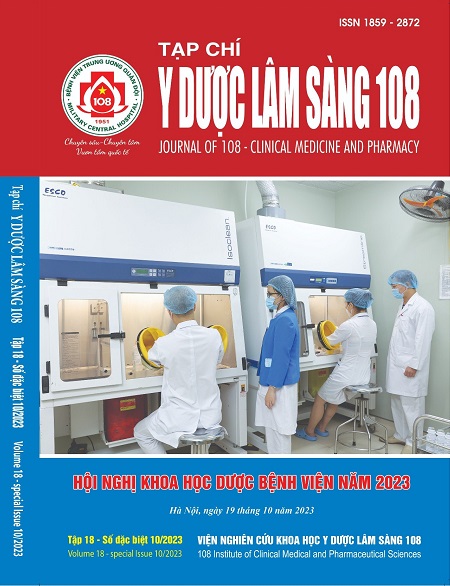Relationship between polypharmacy and falls in patients aged 65 years old or older
Main Article Content
Keywords
Abstract
Objective: This study aimed to assess relationship between falls and polypharmacy in patients aged 65 years old or older. Subject and method: A descriptive cross-sectional study was conducted in 605 patients aged ≥ 65 years from June to December of 2020 at Emergency Department, 108 Military Central Hospital. Polypharmacy was defined as concomitant administration of four or more medications. Information about fall history in the past year, the drugs used was collected based on a designed questionnaire. Result: The rate of falls, multiple falls, traumatic falls in the previous 1 year were 35.7%, 10.6% and 8.8%, respectively. These rates in the polypharmacy group were statistically significantly higher than the non-polypharmacy group. The rate of falls increased with the amount of medication used. Drugs that increase the rate of falls such as benzodiazepines (OR = 4.98), antihypertensive drugs (OR = 1.86), diuretics (OR = 1.83); sedatives and hypnotics drugs (OR = 1.75), antidiabetic drugs (OR = 1.69). Conclusion: Polypharmacy was significantly associated with the rate of falls in the previous 1 year. The higher the rate of falls and the average number of falls in the elderly, especially when using drug classes such as benzodiazepines; antihypertensive drugs; diuretics; sedatives and hypnotics drugs; antidiabetic drugs.
Article Details
References
2. Baranzini F, Poloni N, Diurni M, Ceccon F (2009) Polypharmacy and psychotropic drugs as risk factors for falls in long-term care setting for elderly patients in Lombardy. Recenti Prog Med 10(1): 9-16.
3. Danijela G, Sarah NH, Fiona MB et al (2012) Polypharmacy cutoff and outcomes: Five or more medicines were used to identify community - dwelling older men at risk of different adverse outcomes. Journal of Clinical Epidemiology 65: 989-995.
4. Freeland KN, Thompson AN, Zhao Y, Leal JE et al (2012) Medication use and associated risk of falling in a geriatric outpatient population. Ann Pharmacother 46(9): 1188-1192.
5. Gnjidic D, Hilmer SN, Blyth FM et al (2012) Polypharmacy cutoff and outcomes: Five or more medicines were used to identify community-dwelling older men at risk of different adverse outcomes. J Clin Epidemiol 65(9): 989-995.
6. Morin L, Johnell K, Laroche ML et al (2018) The epidemiology of polypharmacy in older adults: register-based prospective cohort study. Clin Epidemiol 10: 289-298.
7. Richardson K, Bennett K, Kenny RA (2015) Polypharmacy including falls risk-increasing medications and subsequent falls in communitydwelling middle-aged and older adults. Age Ageing 44(1): 90-96.
8. By the 2023 AmericanGeriatrics Society Beers Criteria®Update ExpertPanel (2023) American Geriatrics Society 2023 updated AGS Beers Criteria® for potentially inappropriate medication use in older adults. J Am Geriatr Soc 71: 2052-2081.
9. Stalenhoef PA, Dederiks JP, Knottnerus JA et al (2002) A risk model for the prediction of recurrent falls in community-dwelling elderly: A prospective cohort study. J Clin Epidemiol, 55(11), 1088-1094.
10. Stel V, Smit J, Pluijm S, Lips P (2004) Consequences of falling in older men and women and risk factors for health service use and functional decline. Age Ageing 33: 58-65.
11. Tinetti ME, Kumar C (2010) The patient who falls: It is always a trade-off. JAMA 303(3): 258-266.
12. Weil TP (2015) Patient falls in hospitals: An increasing problem. Geriatr Nurs 36(5): 342-347.
13. WHO (2007) A global report on falls prevention. WHO Technical Meeting on Falls Prevention in Older Age: 1947-1500.
14. Woolcott JC, Richardson KJ, Wiens MO et al (2009) Meta-analysis of the impact of 9 medication classes on falls in elderly persons. Arch Intern Med 169(21): 1952-1960.
15. Zia A, Kamaruzzaman BS, Tan Maw P (2016) The consumption of two or more fall risk-increasing drugs rather than polypharmacy is associated with falls. Geriatr Gerontol Int., doi: 10.1111/ggi.12741.
16. Ziere G, Dieleman J, Hofman A, Pols H et al (2006) Polypharmacy and falls in the middle age and elderly population. Br J Clin Pharmacol 61: 218-223.
 ISSN: 1859 - 2872
ISSN: 1859 - 2872
